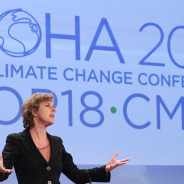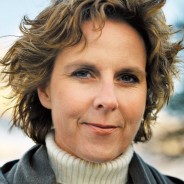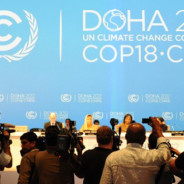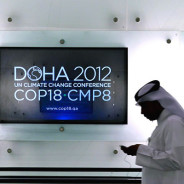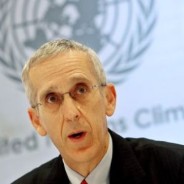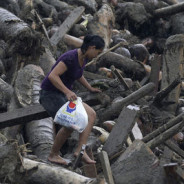COP 18 Doha 2012
La Posizione dell’UE
La Commissione europea ha ufficializzato oggi la posizione che terrà l’Ue alla 18esima Conferenza delle parti dell’United Nations framework convention on climate change(Unfccc) che si terrà a Doha, in Qatar. Ecco il documento integrale: La conferenza delle Nazioni Unite sui cambiamenti climatici che si terrà la prossima settimana a Doha si pone l’obiettivo ambizioso di dare attuazione all’accordo dell’anno scorso per migliorare le azioni globali per il clima. L’Unione europea mira a un risultato che tenga conto di tutti gli elementi del pacchetto di decisioni concordate a Durban, nella prospettiva di un nuovo accordo globale sul clima entro il 2015. L’Unione europea ha chiesto alla presidenza del Qatar di avviare un dibattito ministeriale volto a concordare misure concrete per ridurre le emissioni globali prima del 2020. L’Ue ribadisce fermamente quanto concordato a Durban e il suo impegno a partecipare a una seconda fase del protocollo di Kyoto. L’Ue è ufficialmente il primo fornitore mondiale di assistenza ai paesi emergenti in termini di aiuti allo sviluppo e di finanziamenti legati ai cambiamenti climatici. A Doha l’Ue confermerà, dati alla mano, di essere in linea con la tabella di marcia per l’erogazione dei 7,2 miliardi di euro di finanziamenti rapidi per il clima concordati per il periodo 2010-2012. L’Unione discuterà con i partner in via di sviluppo sul futuro dei principali flussi di finanziamento per il clima dell’Ue nel 2013-2014. Inoltre, l’Ue ribadirà il proprio impegno a fornire la sua parte del finanziamento per il clima di 100 miliardi di dollari annui che i paesi sviluppati destineranno entro il 2020 al sostegno ai paesi in via di sviluppo per la mitigazione delle emissioni e per l’adattamento ai cambiamenti climatici. Connie Hedegaard, Commissaria responsabile per l’Azione per il clima, ha dichiarato: “Doha deve ripartire dai progressi raggiunti a Durban e far progredire i lavori preparatori per giungere a un accordo globale sul clima giuridicamente vincolante entro il 2015. Sarà altrettanto importante accordarsi sulle future misure di riduzione delle emissioni intese a mantenere l’aumento della temperatura globale al di sotto dei 2 °C. L’Ue sta tenendo fede all’impegno di partecipare a una seconda fase...
read moreConnie Hedegaard: Why the Doha climate conference was a success
The Doha climate conference was not a spectacular conference deciding on the 2015 global climate deal, which seems to have come as a surprise to some commentators and environmental groups. But nobody should be surprised. All countries agreed last year in Durban that the climate conferences between then and 2015 would set the stage for the big deal in 2015. Before Doha, the EU presented its checklist to secure progress towards the new climate deal. We can tick them off now. The EU wanted Doha to mark the transition away from the old climate regime, where only developed countries have the legal obligation to reduce emissions, to the new system where all countries, developed and developing alike, will for the first time make legal commitments under the new global agreement. Check. In Doha, we changed the very structure of our negotiations. Before, we had different working groups based on the sharp distinction between developed and developing countries. Now, we have one negotiation forum, the Durban Platform, for all countries. Check. This is not a small achievement. Today, the average emission per capita in China is already 7.2 tonnes and increasing. Europe’s is 7.5 tonnes and decreasing. The world cannot fight climate change without emerging economies committing. That is why crossing the bridge from the old system to the new system was so important. And we did it. And this bridge is being constructed by the EU and a handful of other developed countries committing to a second Kyoto Protocol period. Too many years of hard work would have been lost if we had not renewed Kyoto, which is still the only existing treaty that requires emission cuts. We simply couldn’t afford that. Another check. ✓ We have ensured continuity up to the new global deal in 2020, with the EU succeeding in negotiating an eight-year extension of the protocol. Check. ✓ We have finally resolved the long-running problem of “hot air” – surplus of unused carbon credits from the first Kyoto period. Buyers will be limited in how much they can purchase. The EU’s law doesn’t allow using them and all potential buyers made declarations that...
read moreDoha climate gateway: the reaction
The UN climate talks ended late on Saturday night, with tired delegates relieved that their negotiating ordeal – a marathon 36-hour-final session at the end of the fortnight of talks – was over. Reactions to the outcome since then have mixed, however. The ministers from nearly 200 countries who hammered out the final deal – called the Doha climate gateway – were broadly pleased with it, but they admitted it did not solve all of the issues that needed to be addressed, despite the time spent on it. “This is not perfect, but it is genuine progress,” said Ed Davey, the UK energy and climate change secretary. “It’s a bigger step forward than people have given us credit for. We wanted to pave the way for the future [discussions on a new global treaty] and we’ve done that.” Countries are working towards a new global agreement on climate change that would, unlike the Kyoto protocol, require cuts in greenhouse gas emissions from both developed and developing countries, to be signed in 2015 and come into force from 2020. At Doha, they cleared away some of the obstacles to the proposed new treaty, including starting on a new period of the Kyoto protocol that will last until 2020, reorganising the negotiations into a single unified set of talks, and setting out a work programme of negotiations up to 2015. This was broadly achieved. Connie Hedegaard, the EU climate chief, said: “In Doha, we have crossed the bridge from the old climate regime to the new system. We are now our way to the 2015 global deal. It was not an easy and comfortable ride. It was not a very fast ride either. But we have managed to cross the bridge. Very intense negotiations lie ahead of us. What we need now is more ambition and more speed.”Barack Obama’s special envoy for climate change, Todd Stern, said: “Before we started, I said that this would be a transitional [conference]. There will be growing pains in this process [of negotiating a new treaty] but it’s very important, I think, that we will...
read moreDoha climate change deal clears way for ‘damage aid’ to poor nations
Poor countries have won historic recognition of the plight they face from the ravages of climate change, wringing a pledge from rich nations that they will receive funds to repair the “loss and damage” incurred. This is the first time developing countries have received such assurances, and the first time the phrase “loss and damage from climate change” has been enshrined in an international legal document. Developing countries had been fighting hard for the concession at the fortnight-long UN climate change talks among 195 nations in Qatar, which finished after a marathon 36-hour final session. Ronald Jumeau, negotiating for the Seychelles, scolded the US negotiator: “If we had had more ambition [on emissions cuts from rich countries], we would not have to ask for so much [money] for adaptation. If there had been more money for adaptation [to climate change], we would not be looking for money for loss and damage. What’s next? Loss of our islands?” Ruth Davis, political adviser at Greenpeace, said: “This is a highly significant move – it will be the first time the size of the bill for failing to take on climate change will be part of the UN discussions. Countries need to understand the risks they are taking in not addressing climate change urgently.” Ed Davey, the UK energy and climate secretary, said: “It’s about helping the most vulnerable countries, and looking at how they can be more resilient.” But the pledges stopped well short of any admission of legal liability or the need to pay compensation on the part of the rich world. The US had strongly opposed the initial “loss and damage” proposals, which would have set up a new international institution to collect and disperse funds to vulnerable countries. US negotiators also made certain that neither the word “compensation”, nor any other term connoting legal liability, was used, to avoid opening the floodgates to litigation – instead, the money will be judged as aid. Key questions remain unanswered, including whether funds devoted to “loss and damage” will come from existing humanitarian aid and disaster relief budgets. The US is one...
read moreUS envoy’s cutting remark on C02 emissions fails to add up
The Obama administration has been vigorously defending its climate record at the Doha conference in Qatar. But it appears that Todd Stern, the US state department climate envoy, has been rather selective with his facts. In his sole press conference at the meeting, Stern told reporters the US was on track to meet its commitment on cutting emissions by 2020, citing a report by the Resources for the Future thinktank. The report said that incoming Environmental Protection Agency regulations on coal-fired power plants, along with other measures, could lead to a 16.3% cut in emissions by 2020. “The US has done quite significant things in the president’s first four years, in his first term,” Stern said. “I saw just the other day actually a report by Resources for the Future which is a quite good kind of environmental economic thinktank in Washington that projects us to be on track for about a 16.5% reduction based on the policies that we have in place now.” That figure is not far off Barack Obama’s admittedly modest target of 17% cut on emissions from 2005 levels, which he offered to the UN climate meeting at Copenhagen in 2009. The problem was, however, that Stern overlooked official US government reports indicating the US would be nowhere near a 16% cut by 2020. He also overlooked several different cautions included in the RFF report (pdf). Alden Meyer of the Union of Concerned Scientists, who first drew reporters’ attention to the gap, said the most accurate projections indicate America is well short of meeting even the modest commitment Obama made in 2009 for cutting the emissions that cause climate change. The 2013 outlook from the Energy Information Administration, released just this week, gives a far less rosy picture than Stern. The government agency projected only a 9% reduction in energy-related carbon dioxide emissions by 2020 – and emissions would then creep back up again by 2040. Meyer said Stern’s colleagues at the White House Council for Environmental Quality told him at Doha that US emissions would be down about 10% from 2005 levels. “So clearly the gap to be closed is a...
read moreGulf shows signs of green revolution
It is not the sort of thing you expect to see in the middle of oil-rich Abu Dhabi, but here in a sandy spot by the emirate’s airport is a field of solar panels so vast it could easily blanket several football pitches. It is, say some, a sign of a green revolution poised to transform the Gulf’s energy landscape. This may seem unlikely in a region with a ferocious appetite for air conditioning and desalinated water, and the distinction of being home to the world’s highest per capita emitter of greenhouse gases – Qatar – host of this week’s UN climate talks. “But it’s a necessity,” says Bader al-Lamki, head of clean energy at Masdar, the state-controlled company that built this solar plant to power Masdar City, a cluster of futuristic low-carbon buildings down the road. With 8 per cent of the world’s proven oil reserves, Abu Dhabi is not about to desert the fossil fuel business any time soon, he says. “But we also feel it’s important that renewables step in as a parallel source of energy we should embrace and deploy.” Others are more emphatic about the region’s prospects. “This could be the world’s next renewable energy centre,” says Dubai-based Mark Robson of the Oliver Wyman consultancy, which has just compiled a global ranking of countries’ energy sustainability with the World Energy Council. The top 40 nations did not include a single Gulf country. Read more...
read moreNouveau fiasco pour le climat
Samedi 8 décembre à 3 h 30 (1 h 30 à Paris), quand, sur les écrans du centre de convention de Doha, a été annoncé, sans plus d’explication, le report à 7 h 30 de la réunion où devait être dressé l’état des lieux de la négociation sur le climat, tout le monde a compris que c’était fichu. Qu’il n’y aurait pas d’accord dans la nuit et que la 18e Conférence des Nations unies sur les changements climatiques, qui devait être une simple réunion“sans enjeux majeurs”, entrait dans une zone de grand danger. Le président de la conférence, le Qatari Abdullah Ben Hamad Al-Attiyah, après avoirdemandé aux négociateurs de l’“aider à faire sortir la fumée blanche”, avait déjà repoussé trois fois le rendez-vous fixé initialement à 23 heures vendredi. Que s’est-il passé avant que la conférence ne parte dans le décor ? A cette heure où le manque de sommeil pèse lourd, personne n’avait la réponse. Les rumeurs ont commencé àcirculer et les nerfs à lâcher. Ce qui est sûr, c’est que la journée avait mal commencé et que petit à petit, toutes les discussions se sont grippées. Retour sur une folle nuit dont sont malheureusement coutumiers les diplomates du climat. “La présidence a mal utilisé les ministres, nous sommes dans la confusion la plus totale”,déplore Tim Gore, de l’ONG Oxfam, qui, comme beaucoup, a vu nombre de ministres déambuler dans les immenses couloirs du centre de convention. Peu auparavant, la ministre brésilienne de l’environnement, Izabella Teixeira, a rejoint ses conseillers dans le hall, sous l’immense araignée de métal sculptée par Louise Bourgeois : “Il y a un endroit où je peux dormir ?”, implore-t-elle. “LES AMÉRICAINS NE VEULENT RIEN DONNER” L’équipe américaine, elle, reste sur le pied de guerre. “Les Américains veulent faire sauterdouze paragraphes dans un texte. Les pays émergents sont furieux“, affirme, de “source sûre”, un participant. Todd Stern, l’envoyé spécial de Hillary Clinton, tient conseil, sandwich et café à la main, dans la cafétéria. Toute la semaine, il a plutôt joué la discrétion. Fausse impression. “C’est toujours comme ça, les Américains font profil bas parce qu’ils ne veulent rien donner. Mais quand on franchit leur ligne rouge, ils contre-attaquent”, décrypte un négociateur africain qui préfèrealler s’installer ailleurs : “Je ne peux plus supporter leur arrogance. Ils sont...
read more
